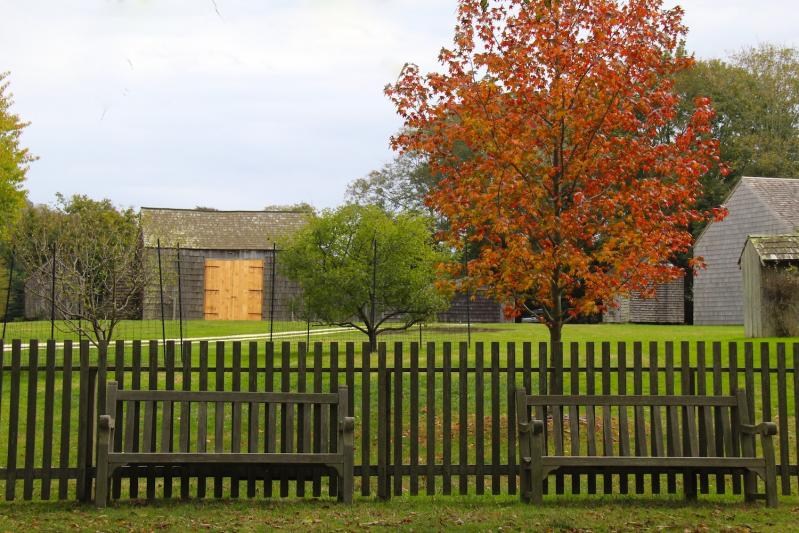History was at the heart of two hearings at Friday’s East Hampton Village Zoning Board of Appeals meeting. One involved a new barn for the East Hampton Historical Society on the grounds of the Mulford Farm on James Lane, which it manages, and the other proposed updates for a historic Main Street home.
The historical society is seeking a special permit and several variances from the Z.B.A. to bring 2023-level technology to a new barn that would house its growing collection of historical artifacts. Steve Long, executive director, told the board the new building will have state of the art climate control, fire suppression, and security systems.
A small storage shed would be removed to make space for the proposed 80-by-36-foot barn, which also needs a 2,630-square-foot variance (the village limits accessory buildings to 250 square feet). A second variance is needed because the accessory structure will be 23.5 feet tall, 9.5 feet taller than the permitted height.
Mr. Long listed some of the artifacts in the society’s collection that would be housed in the new storage barn, including a wig owned by Samuel Buell, the third minister of the East Hampton Presbyterian Church.
“The wig was used by Colonial Williamsburg to find out how 18th-century wigs were made,” he said. He also highlighted “an amazing collection of the material culture of the Montaukett People and a large collection of Dominy clocks and furniture.” Those items, said Mr. Long, are now stored in substandard conditions.
The new barn would be large enough to include a research space. “We have researchers come and we don’t have a proper facility for them to look at our collection. It’s a bit of an embarrassment,” he said.
The board questioned the proposed metal roof. The lawyer speaking for the society, Tom Osborn, said using metal would save the society money.
“We’re proposing to recreate the current storage barn that was built in the 1970s,” Mr. Osborn explained. “A metal roof would be the one difference. It’s similar to one on St. Luke’s, but otherwise it would look like a barn.”
The board decided to keep the hearing open for comments before its next meeting.
Zoning board meetings are rarely heartwarming, but a discussion of a historic house at 146 Main Street, now known as The Rosary L.L.C., came close. Both Andrew Rose, its owner, and his neighbor, Karel Deboer, placed neighborliness ahead of all else.
Mr. Rose addressed the board with ancestral bona fides. “I am a direct descendent of Ezekiel Sandford, who built the bridge in Bridgehampton in 1680.” He went on to explain why he needs to add a stairwell and a small section of second story to his home.
His parents, who have lived there for the last 20 years, are now unable to access the upstairs, he explained. Access to the second floor is only through a “very steep back staircase that my father fell from at least twice, once breaking his shoulder.”
Improvement of the stairwell is a major safety issue, he said. “Both for egress to get up and down from the second story, but also in case of fire.”
“Houses have to evolve over time,” Mr. Rose said. “It’s a very historic house, and we’ve always maintained historic houses.”
He has hired Pamela Pospisil, a Southampton architect, who has submitted plans to redo the back of the house, “but not touching the historic part.”
Mr. Rose’s neighbor, Mr. Deboer, told the zoning board that “I’m one of the three year-round residents on Main Street, though that’s a sad statement to make.” While he is concerned that the new roofline created by the second-story addition could affect the light his house receives, he stressed that “I want to be good neighbors to the Roses, who are good neighbors to me.”
To address Mr. Deboer’s concerns, Mr. Rose worked with Ms. Pospisil to drop the roof line four and a half feet. He is seeking the smallest variance possible to complete his renovation — “less than half the size of the tables you’re sitting at now,” he told the board.
John Huber, a lawyer speaking for Mr. Rose, noted that to further accommodate Mr. Deboer, the Rose family has agreed to remove 220 square feet of an existing brick patio.
The hearing was closed; a determination awaits.
Also on Friday, the zoning board ruled against a gazebo for which Carl Icahn had sought retroactive approval, as well as a proposed fence and lighting on the dune at his 16 Nichols Lane residence. The board did, however, okay a proposed shed, bin, and walkway, with conditions.




